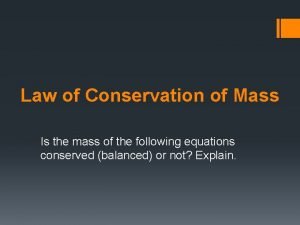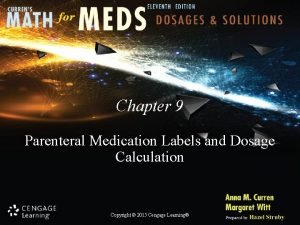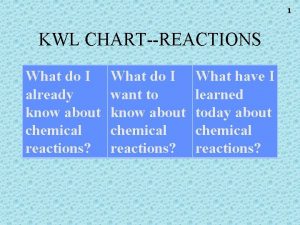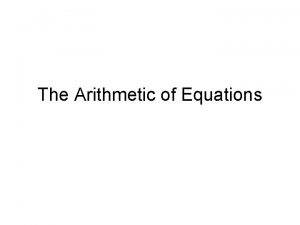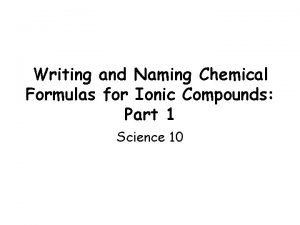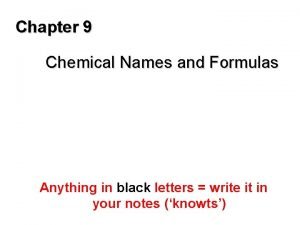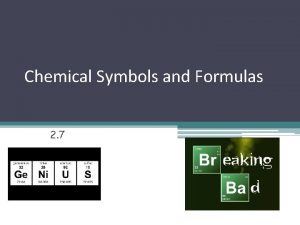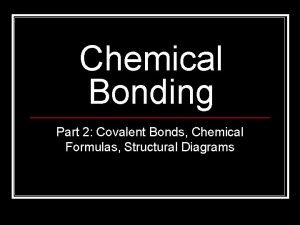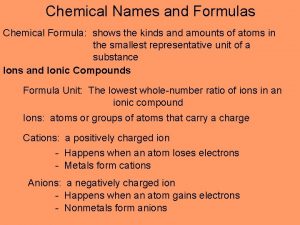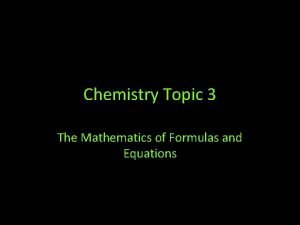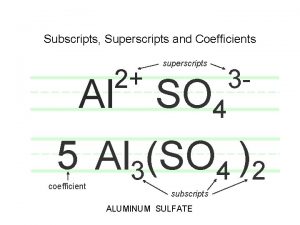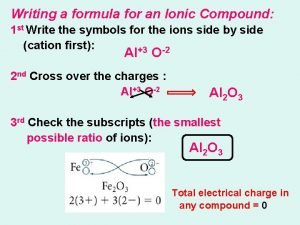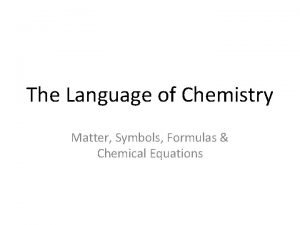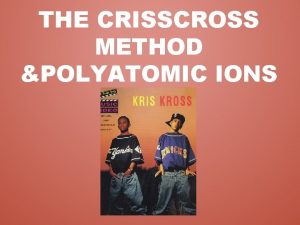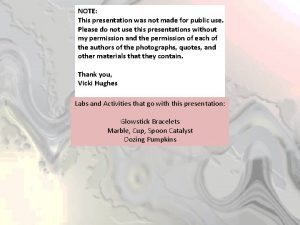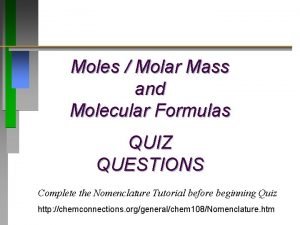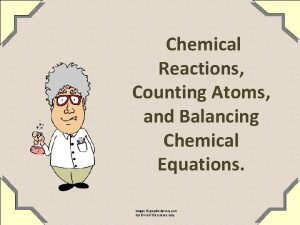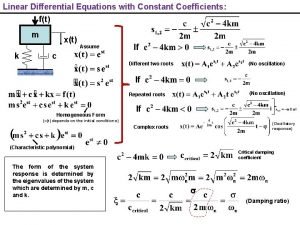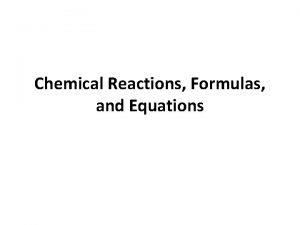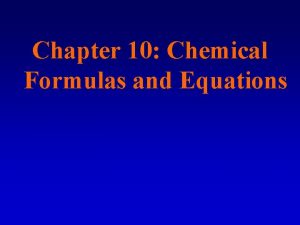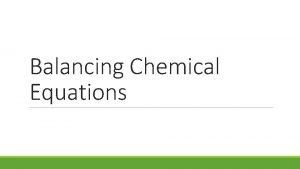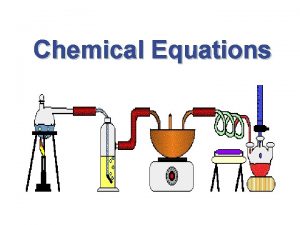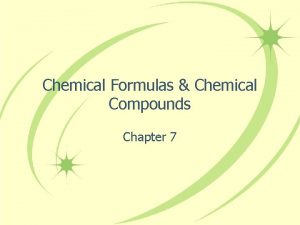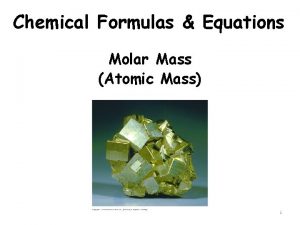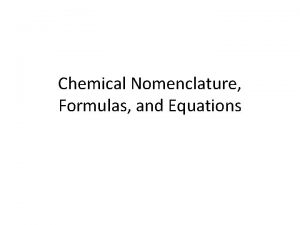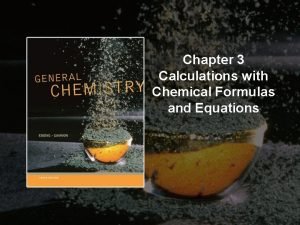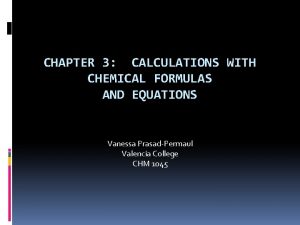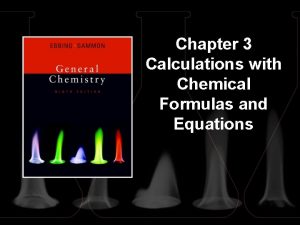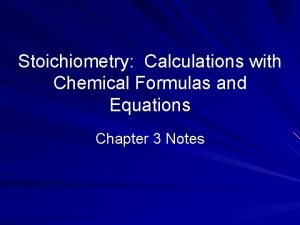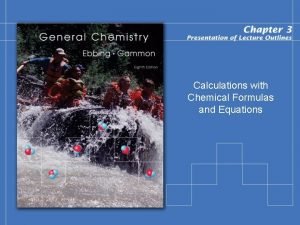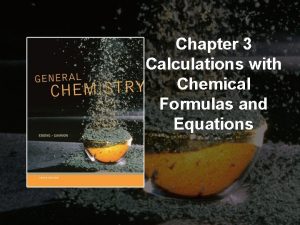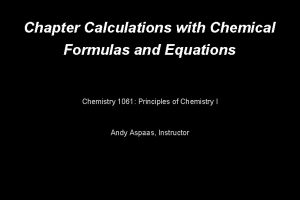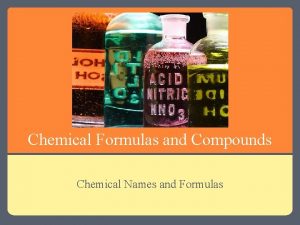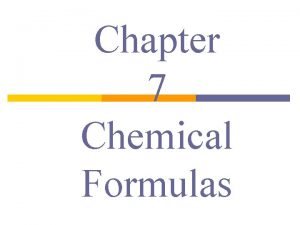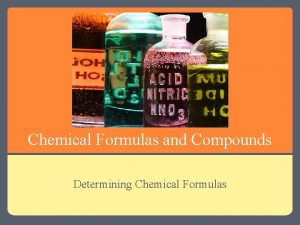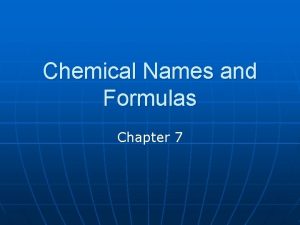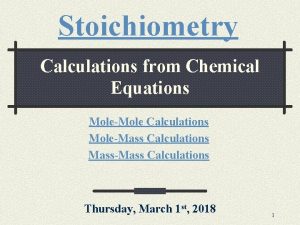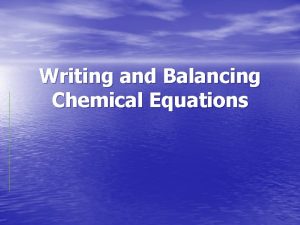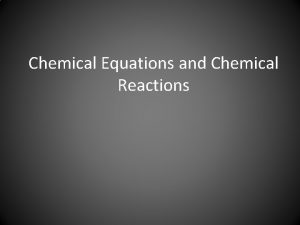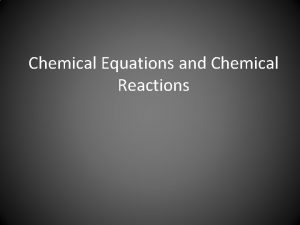Calculations with Chemical Formulas and Equations Mass and



































- Slides: 35

Calculations with Chemical Formulas and Equations

Mass and Moles of a Substance • Chemistry requires a method for determining the numbers of molecules in a given mass of a substance. – This allows the chemist to carry out “recipes” for compounds based on the relative numbers of atoms involved. – The calculation involving the quantities of reactants and products in a chemical equation is called stoichiometry. Copyright © Houghton Mifflin Company. All rights reserved. 2

Molecular Weight and Formula Weight • The molecular weight of a substance is the sum of the atomic weights of all the atoms in a molecule of the substance. – For, example, a molecule of H 2 O contains 2 hydrogen atoms (at 1. 0 amu each) and 1 oxygen atom (16. 0 amu), giving a molecular weight of 18. 0 amu. Copyright © Houghton Mifflin Company. All rights reserved. 3

Molecular Weight and Formula Weight • The formula weight of a substance is the sum of the atomic weights of all the atoms in one formula unit of the compound, whether molecular or not. – For example, one formula unit of Na. Cl contains 1 sodium atom (23. 0 amu) and one chlorine atom (35. 5 amu), giving a formula weight of 58. 5 amu. Copyright © Houghton Mifflin Company. All rights reserved. 4

Mass and Moles of a Substance • The Mole Concept – A mole is defined as the quantity of a given substance that contains as many molecules or formula units as the number of atoms in exactly 12 grams of carbon– 12. (See Figure 3. 2) – The number of atoms in a 12 -gram sample of carbon– 12 is called Avogadro’s number (to which we give the symbol Na). The value of Avogadro’s number is 6. 02 x 1023. Copyright © Houghton Mifflin Company. All rights reserved. 5

Mass and Moles of a Substance • The molar mass of a substance is the mass of one mole of a substance. – For all substances, molar mass, in grams per mole, is numerically equal to the formula weight in atomic mass units. – That is, one mole of any element weighs its atomic mass in grams. Copyright © Houghton Mifflin Company. All rights reserved. 6

Mass and Moles of a Substance • Mole calculations – Converting the number of moles of a given substance into its mass, and vice versa, is fundamental to understanding the quantitative nature of chemical equations. Copyright © Houghton Mifflin Company. All rights reserved. 7

Mass and Moles of a Substance • Mole calculations – Suppose we have 100. 0 grams of iron (Fe). The atomic weight of iron is 55. 8 g/mol. How many moles of iron does this represent? Copyright © Houghton Mifflin Company. All rights reserved. 8

Mass and Moles of a Substance • Mole calculations – Conversely, suppose we have 5. 75 moles of magnesium (atomic wt. = 24. 3 g/mol). What is its mass? Copyright © Houghton Mifflin Company. All rights reserved. 9

Mass and Moles of a Substance • Mole calculations – This same method applies to compounds. Suppose we have 100. 0 grams of H 2 O (molecular weight = 18. 0 g/mol). How many moles does this represent? Copyright © Houghton Mifflin Company. All rights reserved. 10

Mass and Moles of a Substance • Mole calculations – Conversely, suppose we have 3. 25 moles of glucose, C 6 H 12 O 6 (molecular wt. = 180. 0 g/mol). What is its mass? Copyright © Houghton Mifflin Company. All rights reserved. 11

Mass and Moles and Number of Molecules or Atoms • The number of molecules or atoms in a sample is related to the moles of the substance: • Suppose we have a 3. 46 -g sample of hydrogen chloride, HCl. How many molecules of HCl does this represent? Copyright © Houghton Mifflin Company. All rights reserved. 12

Determining Chemical Formulas • The percent composition of a compound is the mass percentage of each element in the compound. – We define the mass percentage of “A” as the parts of “A” per hundred parts of the total, by mass. That is, Copyright © Houghton Mifflin Company. All rights reserved. 13

Mass Percentages from Formulas • Let’s calculate the percent composition of butane, C 4 H 10. First, we need the molecular mass of C 4 H 10. Now, we can calculate the percents. Copyright © Houghton Mifflin Company. All rights reserved. 14

Determining Chemical Formulas • Determining the formula of a compound from the percent composition. – The percent composition of a compound leads directly to its empirical formula. – An empirical formula (or simplest formula) for a compound is the formula of the substance written with the smallest integer (whole number) subscripts. Copyright © Houghton Mifflin Company. All rights reserved. 15

Determining Chemical Formulas • Determining the empirical formula from the percent composition. – Benzoic acid is a white, crystalline powder used as a food preservative. The compound contains 68. 8% C, 5. 0% H, and 26. 2% O by mass. What is its empirical formula? – In other words, give the smallest whole-number ratio of the subscripts in the formula C x H y. O z Copyright © Houghton Mifflin Company. All rights reserved. 16

Determining Chemical Formulas • Determining the empirical formula from the percent composition. – For the purposes of this calculation, we will assume we have 100. 0 grams of benzoic acid. – Then the mass of each element equals the numerical value of the percentage. – Since x, y, and z in our formula represent mole ratios, we must first convert these masses to moles. C x H y. O z Copyright © Houghton Mifflin Company. All rights reserved. 17

Determining Chemical Formulas • Determining the empirical formula from the percent composition. – Our 100. 0 grams of benzoic acid would contain: This isn’t quite a whole number ratio, but if we divide each number by the smallest of the three, a better ratio might emerge. Copyright © Houghton Mifflin Company. All rights reserved. 18

Determining Chemical Formulas • Determining the empirical formula from the percent composition. – Our 100. 0 grams of benzoic acid would contain: now it’s not too difficult to See that the smallest whole number ratio is 7: 6: 2. The empirical formula is C 7 H 6 O 2. Copyright © Houghton Mifflin Company. All rights reserved. 19

Determining Chemical Formulas • Determining the molecular formula from the empirical formula. – An empirical formula gives only the smallest whole -number ratio of atoms in a formula. – The molecular formula should be a multiple of the empirical formula (since both have the same percent composition). – To determine the molecular formula, we must know the molecular weight of the compound. Copyright © Houghton Mifflin Company. All rights reserved. 20

Determining Chemical Formulas • Determining the molecular formula from the empirical formula. – For example, suppose the empirical formula of a compound is CH 2 O and its molecular weight is 60. 0 g/mol. – The molar weight of the empirical formula (the empirical weight) is only 30. 0 g/mol. – This would imply that the molecular formula is actually the empirical formula doubled, or C 2 H 4 O 2 Copyright © Houghton Mifflin Company. All rights reserved. 21

Stoichiometry: Quantitative Relations in Chemical Reactions • Stoichiometry is the calculation of the quantities of reactants and products involved in a chemical reaction. – It is based on the balanced chemical equation and on the relationship between mass and moles. – Such calculations are fundamental to most quantitative work in chemistry. Copyright © Houghton Mifflin Company. All rights reserved. 22

Molar Interpretation of a Chemical Equation • The balanced chemical equation can be interpreted in numbers of molecules, but generally chemists interpret equations as “mole-to-mole” relationships. – For example, the Haber process for producing ammonia involves the reaction of hydrogen and nitrogen. (See Figure 3. 12) Copyright © Houghton Mifflin Company. All rights reserved. 23

Molar Interpretation of a Chemical Equation • This balanced chemical equation shows that one mole of N 2 reacts with 3 moles of H 2 to produce 2 moles of NH 3. 1 molecule N 2 + 3 molecules H 2 2 molecules NH 3 – Because moles can be converted to mass, you can also give a mass interpretation of a chemical equation. Copyright © Houghton Mifflin Company. All rights reserved. 24

Molar Interpretation of a Chemical Equation • Suppose we wished to determine the number of moles of NH 3 we could obtain from 4. 8 mol H 2. – Because the coefficients in the balanced equation represent mole-to-mole ratios, the calculation is simple. Copyright © Houghton Mifflin Company. All rights reserved. 25

Mass Relationships in Chemical Equations • Amounts of substances in a chemical reaction by mass. – How many grams of HCl are required to react with 5. 00 grams manganese dioxide according to this equation? Copyright © Houghton Mifflin Company. All rights reserved. 26

Mass Relationships in Chemical Equations • First, you write what is given (5. 00 g Mn. O 2) and convert this to moles. • Then convert to moles of what is desired. (mol HCl) • Finally, you convert this to mass (g HCl) Copyright © Houghton Mifflin Company. All rights reserved. 27

Limiting Reagent • The limiting reactant (or limiting reagent) is the reactant that is entirely consumed when the reaction goes to completion. – The limiting reagent ultimately determines how much product can be obtained. – For example, bicycles require one frame and two wheels. If you have 20 wheels but only 5 frames, it is clear that the number of frames will determine how many bicycles can be made. Copyright © Houghton Mifflin Company. All rights reserved. 28

Limiting Reagent • Zinc metal reacts with hydrochloric acid by the following reaction. – If 0. 30 mol Zn is added to hydrochloric acid containing 0. 52 mol HCl, how many moles of H 2 are produced? Copyright © Houghton Mifflin Company. All rights reserved. 29

Limiting Reagent • Take each reactant in turn and ask how much product would be obtained if each were totally consumed. The reactant that gives the smaller amount is the limiting reagent. • Since HCl is the limiting reagent, the amount of H 2 produced must be 0. 26 mol. Copyright © Houghton Mifflin Company. All rights reserved. 30

Theoretical and Percent Yield • The theoretical yield of product is the maximum amount of product that can be obtained from given amounts of reactants. – The percentage yield is the actual yield (experimentally determined) expressed as a percentage of theoretical yield (calculated). Copyright © Houghton Mifflin Company. All rights reserved. 31

Theoretical and Percent Yield • To illustrate the calculation of percentage yield, recall that theoretical yield of H 2 in the previous example was 0. 26 mol (or 0. 52 g) H 2. • If the actual yield of the reaction had been 0. 22 g H 2, then Copyright © Houghton Mifflin Company. All rights reserved. 32

Operational Skills • • • Calculating the formula weight from a formula. Calculating the mass of an atom or molecule. Converting moles of substance to grams and vice versa. Calculating the number of molecules in a given mass. Calculating the percentage composition from the formula. Calculating the mass of an element in a given mass of compound. Calculating the percentages C and H by combustion. Determining the empirical formula from percentage composition. Determining the true molecular formula. Relating quantities in a chemical equation. Calculating with a limiting reagent. Copyright © Houghton Mifflin Company. All rights reserved. 33

Figure 3. 2: One mole each of various substances. Photo courtesy of American Color. Return to Slide 5 Copyright © Houghton Mifflin Company. All rights reserved. 34

Figure 3. 12: The Haber process for producing ammonia. Return to Slide 22 Copyright © Houghton Mifflin Company. All rights reserved. 35
 Chapter 7 review chemical formulas and chemical compounds
Chapter 7 review chemical formulas and chemical compounds Modern chemistry chapter 7 review answers
Modern chemistry chapter 7 review answers Types of connections in steel structures
Types of connections in steel structures Are kc and kp equal
Are kc and kp equal State the law of conservation of mass
State the law of conservation of mass Translating chemical equations
Translating chemical equations Parenteral dosage examples
Parenteral dosage examples Dc shunt motor equations
Dc shunt motor equations The calculation of quantities in chemical equations
The calculation of quantities in chemical equations Kwl chart of chemical formula
Kwl chart of chemical formula The arithmetic of equations
The arithmetic of equations In an ionic compound the chemical formula represents
In an ionic compound the chemical formula represents Chapter 9 chemical names and formulas
Chapter 9 chemical names and formulas Chapter 9 chemical names and formulas answer key
Chapter 9 chemical names and formulas answer key Chapter 9 chemical names and formulas chapter quiz answers
Chapter 9 chemical names and formulas chapter quiz answers Counting atoms worksheet
Counting atoms worksheet What is formula of mole
What is formula of mole Covalent compound formula
Covalent compound formula Naming hydrates
Naming hydrates Chemical names and formulas
Chemical names and formulas Topic 3 the mathematics of formulas and equations
Topic 3 the mathematics of formulas and equations 2-5 literal equations and formulas
2-5 literal equations and formulas Criss cross method steps
Criss cross method steps Subscript in chemical formula
Subscript in chemical formula Writing the formula for ionic compounds
Writing the formula for ionic compounds Language of chemistry
Language of chemistry Criss cross method
Criss cross method Chemical formulas
Chemical formulas Chemical formulas
Chemical formulas Empirical and molecular formula quiz
Empirical and molecular formula quiz Counting atoms examples
Counting atoms examples Trigonometric functions formula
Trigonometric functions formula Coefficient method
Coefficient method Lesson 5-3 solving trigonometric equations
Lesson 5-3 solving trigonometric equations Chemistry chapter 8 review chemical equations and reactions
Chemistry chapter 8 review chemical equations and reactions Chapter 8 section 1 chemical equations and reactions
Chapter 8 section 1 chemical equations and reactions




